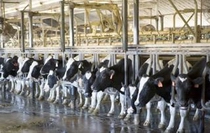
"We've moved from a really bullish scenario to more of a neutral one in the last month," says University of Missouri economist Joe Horner. "That's mostly because the milk production reports have started to show an increase in the herd and in milk production per cow."
Similar to the beef and hog sectors, last year saw some high cow slaughter numbers as feed costs soared because of the drought. That's caused a lot of producers to cull lower-producing cows as one way to try to button up efficiencies and shore up poor production after feeding last year's drought-shortened, poorer-quality forage supplies.
"We’ve been fighting this teeter-totter of coarser feeds this year, more drought-stressed forages, higher feed costs, higher ration costs, people not feeding their cows as well, but at the same time culling out all the low-end cows," Horner says "So we've been right at year-ago levels for the last six months, and finally late in the fall we started to pick up milk volumes on a per-cow basis."
At the same time, export demand for U.S. milk and dairy products is slowly growing, helping push prices beyond breakeven levels for the year.
"Increasingly, our dairy prices are dependent in what is going on in the export market around the world,” Horner says in a university report. "Everyone is excited about China. China is a huge market and growth area for us, but Mexico tends to be our biggest customer. It is not rising as fast as China, but it is by far the largest buyer of U.S. dairy and it is continuing to rise.
"The estimated Missouri farm-level price for the first half of 2013 is $19.54 per hundredweight. We are forecasting a $20 farm-level milk price for the second half of 2013, and with any help at all on the demand side we think that could be higher. For all of 2013 we are forecasting about a $19.77 farm-level milk price in Missouri. That is down slightly from last fall, but should still be above break-even for the average producer in Missouri.”





